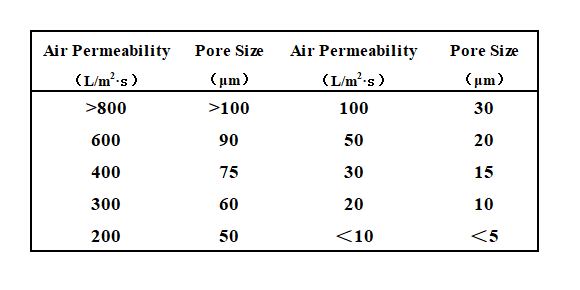
Mesh fabrics use the term “mesh” to indicate the pore size, which is inaccurate for woven filter fabrics. First of all, the pore size of woven filter fabrics is much smaller than the traditional mesh measurement range. Secondly, the filter pore of filter cloth is not only interwoven yarn pores, but also gaps between fibers. The diameter of particles that can pass through these gaps is called the equivalent pore, measured in microns (μm). The conversion between mesh and pore size is 14300/mesh=pore size(μm). To have a clearer indication of the tightness of a woven filter cloth, air permeability is used as an indicator, measured in L/m2.s. There is a relationship between air permeability and pore size, as shown in the table.

The above table is empirical data that can be used as a reference for the design and selection of industrial filter cloth. The relationship between the air permeability and the pore size changes greatly based on the filter cloth raw material and fabric structure.
In general, for fabrics with relatively low density of warp and weft, the area of the filter pores covered by the interwoven yarn pores is larger, while for fabrics with high density of warp and weft, most of the pores are located between the fibers of the yarn. Therefore, the pore size of the filter cloth with small tightness has poor uniformity, while fabrics with high tightness has good uniformity. The pore size is usually expressed as the equivalent pore size, which can be tested by the bubble test. Due to the pressure in the filtration process, filter press fabric requires high tightness to play its advantages.